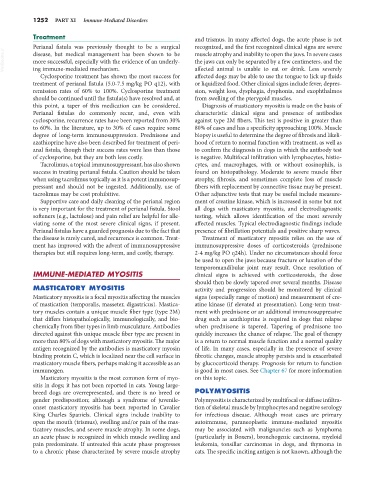Page 1280 - Small Animal Internal Medicine, 6th Edition
P. 1280
1252 PART XI Immune-Mediated Disorders
Treatment and trismus. In many affected dogs, the acute phase is not
Perianal fistula was previously thought to be a surgical recognized, and the first recognized clinical signs are severe
VetBooks.ir disease, but medical management has been shown to be muscle atrophy and inability to open the jaws. In severe cases
the jaws can only be separated by a few centimeters, and the
more successful, especially with the evidence of an underly-
ing immune-mediated mechanism.
affected dogs may be able to use the tongue to lick up fluids
Cyclosporine treatment has shown the most success for affected animal is unable to eat or drink. Less severely
treatment of perianal fistula (5.0-7.5 mg/kg PO q12), with or liquidized food. Other clinical signs include fever, depres-
remission rates of 60% to 100%. Cyclosporine treatment sion, weight loss, dysphagia, dysphonia, and exophthalmos
should be continued until the fistula(s) have resolved and, at from swelling of the pterygoid muscles.
this point, a taper of this medication can be considered. Diagnosis of masticatory myositis is made on the basis of
Perianal fistulas do commonly recur, and, even with characteristic clinical signs and presence of antibodies
cyclosporine, recurrence rates have been reported from 30% against type 2M fibers. This test is positive in greater than
to 60%. In the literature, up to 30% of cases require some 80% of cases and has a specificity approaching 100%. Muscle
degree of long-term immunosuppression. Prednisone and biopsy is useful to determine the degree of fibrosis and likeli-
azathioprine have also been described for treatment of peri- hood of return to normal function with treatment, as well as
anal fistula, though their success rates were less than those to confirm the diagnosis in dogs in which the antibody test
of cyclosporine, but they are both less costly. is negative. Multifocal infiltration with lymphocytes, histio-
Tacrolimus, a topical immunosuppressant, has also shown cytes, and macrophages, with or without eosinophils, is
success in treating perianal fistula. Caution should be taken found on histopathology. Moderate to severe muscle fiber
when using tacrolimus topically as it is a potent immunosup- atrophy, fibrosis, and sometimes complete loss of muscle
pressant and should not be ingested. Additionally, use of fibers with replacement by connective tissue may be present.
tacrolimus may be cost prohibitive. Other adjunctive tests that may be useful include measure-
Supportive care and daily cleaning of the perianal region ment of creatine kinase, which is increased in some but not
is very important for the treatment of perianal fistula. Stool all dogs with masticatory myositis, and electrodiagnostic
softeners (e.g., lactulose) and pain relief are helpful for alle- testing, which allows identification of the most severely
viating some of the most severe clinical signs, if present. affected muscles. Typical electrodiagnostic findings include
Perianal fistulas have a guarded prognosis due to the fact that presence of fibrillation potentials and positive sharp waves.
the disease is rarely cured, and recurrence is common. Treat- Treatment of masticatory myositis relies on the use of
ment has improved with the advent of immunosuppressive immunosuppressive doses of corticosteroids (prednisone
therapies but still requires long-term, and costly, therapy. 2-4 mg/kg PO q24h). Under no circumstances should force
be used to open the jaws because fracture or luxation of the
temporomandibular joint may result. Once resolution of
IMMUNE-MEDIATED MYOSITIS clinical signs is achieved with corticosteroids, the dose
should then be slowly tapered over several months. Disease
MASTICATORY MYOSITIS activity and progression should be monitored by clinical
Masticatory myositis is a focal myositis affecting the muscles signs (especially range of motion) and measurement of cre-
of mastication (temporalis, masseter, digastricus). Mastica- atine kinase (if elevated at presentation). Long-term treat-
tory muscles contain a unique muscle fiber type (type 2M) ment with prednisone or an additional immunosuppressive
that differs histopathologically, immunologically, and bio- drug such as azathioprine is required in dogs that relapse
chemically from fiber types in limb musculature. Antibodies when prednisone is tapered. Tapering of prednisone too
directed against this unique muscle fiber type are present in quickly increases the chance of relapse. The goal of therapy
more than 80% of dogs with masticatory myositis. The major is a return to normal muscle function and a normal quality
antigen recognized by the antibodies is masticatory myosin of life. In many cases, especially in the presence of severe
binding protein C, which is localized near the cell surface in fibrotic changes, muscle atrophy persists and is exacerbated
masticatory muscle fibers, perhaps making it accessible as an by glucocorticoid therapy. Prognosis for return to function
immunogen. is good in most cases. See Chapter 67 for more information
Masticatory myositis is the most common form of myo- on this topic.
sitis in dogs; it has not been reported in cats. Young large-
breed dogs are overrepresented, and there is no breed or POLYMYOSITIS
gender predisposition; although a syndrome of juvenile- Polymyositis is characterized by multifocal or diffuse infiltra-
onset masticatory myositis has been reported in Cavalier tion of skeletal muscle by lymphocytes and negative serology
King Charles Spaniels. Clinical signs include inability to for infectious disease. Although most cases are primary
open the mouth (trismus), swelling and/or pain of the mas- autoimmune, paraneoplastic immune-mediated myositis
ticatory muscles, and severe muscle atrophy. In some dogs, may be associated with malignancies such as lymphoma
an acute phase is recognized in which muscle swelling and (particularly in Boxers), bronchogenic carcinoma, myeloid
pain predominate. If untreated this acute phase progresses leukemia, tonsillar carcinomas in dogs, and thymoma in
to a chronic phase characterized by severe muscle atrophy cats. The specific inciting antigen is not known, although the

